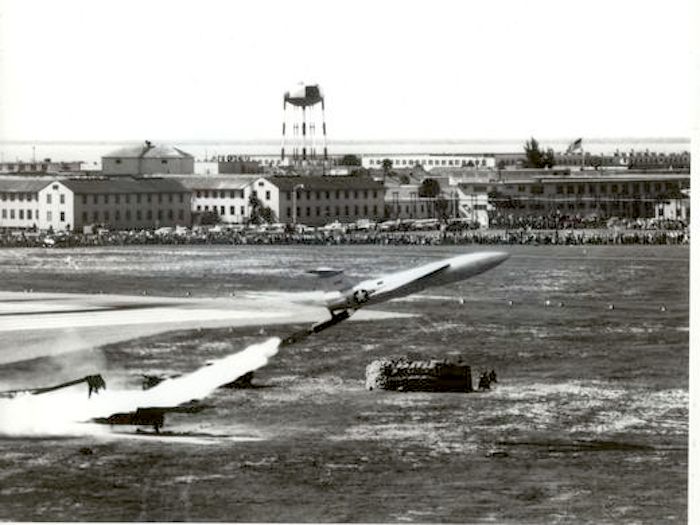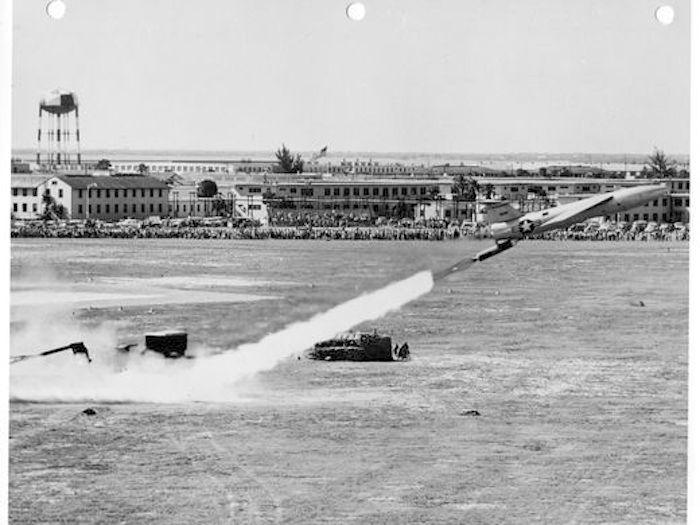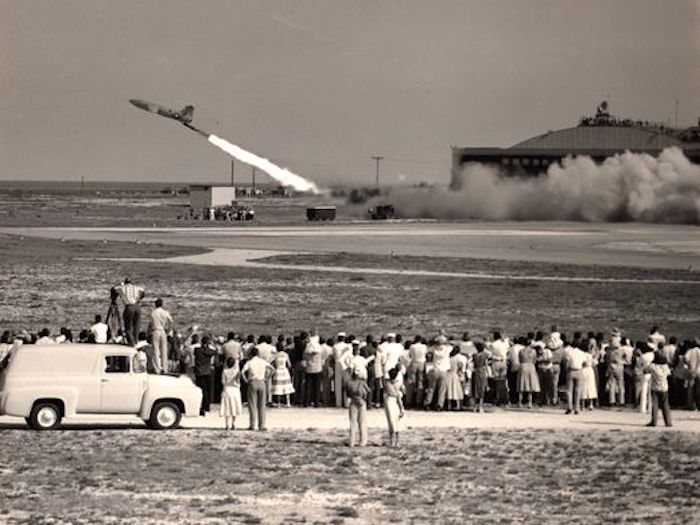.

Armed Forces Day attracted little notice Saturday , but 60 years ago the occasion drew throngs to Patrick Air Force Base.
Cars lined State Road A1A before it was closed to traffic at 3:30 p.m. on May 20, 1956, as an estimated 25,000 people gathered to see something few ever had up close: a missile launch.
John Hilliard, then 18, bicycled down from his home on the base’s north end to a roped-off softball field where a winged TM-61 Matador missile nicknamed “Florida Ranger” sat perched on a mobile launcher, just a few hundred yards away.
Officials briefed the crowd on the 29-foot-long surface-to-surface cruise missile before a late-afternoon countdown that culminated at “X minus zero,” when an officer pushed a button from a nearby control station shielded by sand bags.
“There was a large roar and the thing lifted off,” recalls Hilliard, of Satellite Beach. “There was a lot of noise and a lot of cheering after the liftoff. I thought it was very fascinating; it was something I’d never seen.”
And something no one has seen since: a launch from Patrick, rather than up the road on Cape Canaveral Air Force Station, where the public has only ever gotten within miles of liftoffs by now much larger rockets.
Air Force and news reports described the public launch as the first of its kind.
The crowd including children sitting on their parents’ shoulders watched the 12,000-pound Matador unleash a torrent of flame and smoke from a solid-fueled rocket motor as it shot east across A1A and out over the ocean.
Within seconds the motor burned out and dropped away “like an autumn leaf,” according to an account in the base newspaper, “The Missileer.”
Resembling a jet fighter, the Matador continued its flight powered by a turbojet engine, and pursued by an F-86 chase plane.
“I was blown away,” remembers Steve Goldsmith of Cape Canaveral, then 6 years old. “It was really something to see, being right next to a missile when they shot it up. It was quite a sight.”
The Air Force called the missile test a success but did not detail its flight. The Matador could fly at 650 mph and as high as 35,000 feet, with a range of more than 600 miles.
“At the time, the Matador was the missile,” said Roger McCormick, a 55-year-old Merritt Island resident and former space shuttle technician who, like Hilliard and Goldsmith, volunteers at the Air Force Space and Missile Museum at Cape Canaveral Air Force Station.
“That was one of our primary missile systems that was being developed at the Cape,” McCormick continued. “And to have a chance to see it up close and actually see it fly – I wish I had been here for that. I’m sure it was very exciting for the people.”
Known as “pilotless bombers,” the winged Matadors were deployed in Europe, Taiwan and Korea in the 1950s before being replaced by more advanced inter-continental ballistic missiles.
Patrick’s missile launch drew widespread publicity and served its purpose of inspiring pride in a relatively new military technology.
By the next year, the Soviet Union’s launch of Sputnik, followed by a Vanguard rocket’s spectacular failure seconds after liftoff from Cape Canaveral, would make the nation anxious about a new space race it appeared to be losing.
But 60 years ago on Armed Forces Day, the one-of-a-kind launch from Patrick Air Force Base also encouraged some, like Hilliard, to live that space race through careers in missile and rocket launches.
“It was a big deal for me seeing a rocket launch,” said Hilliard, a retired Air Force colonel. “That was the first public display of a launching of a missile. And it was the only one from Patrick.”
-

-

-

Quelle: Florida Today
3665 Views
